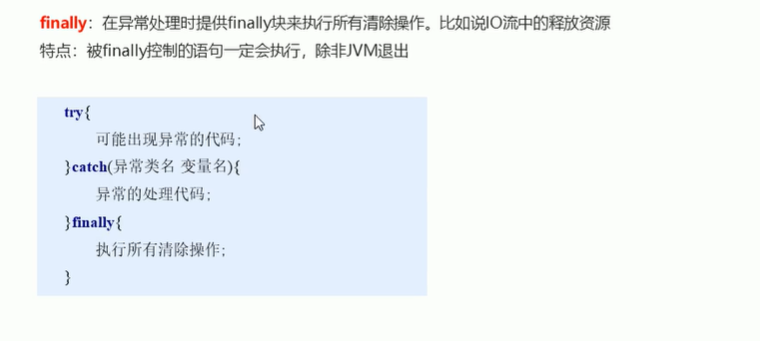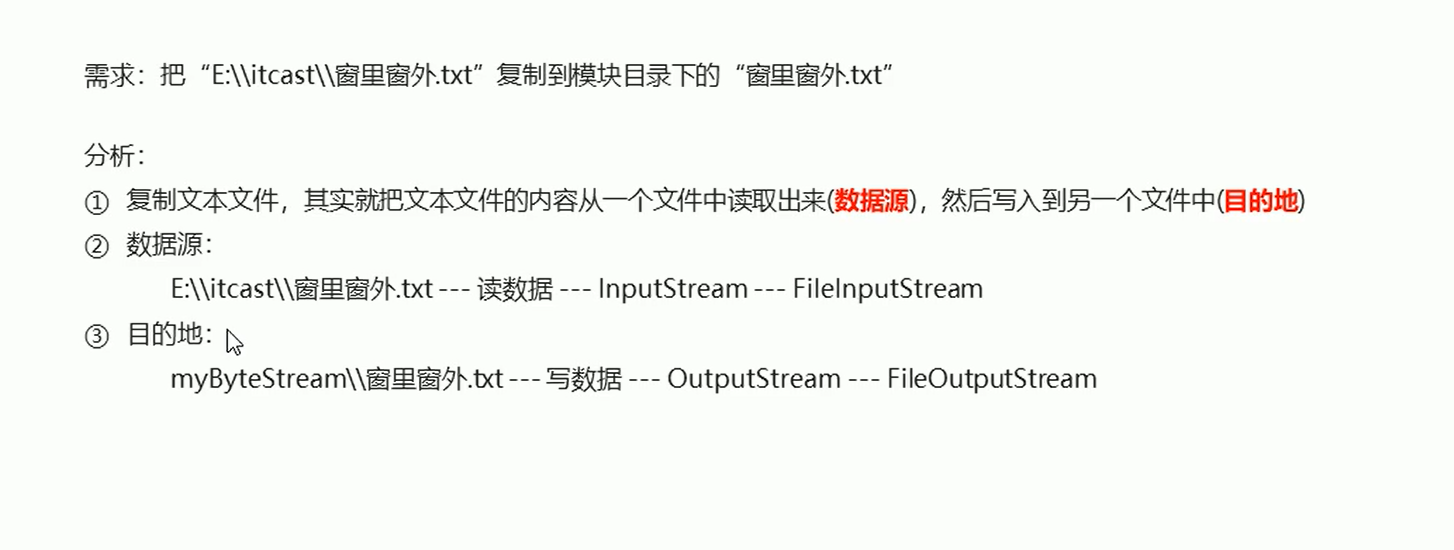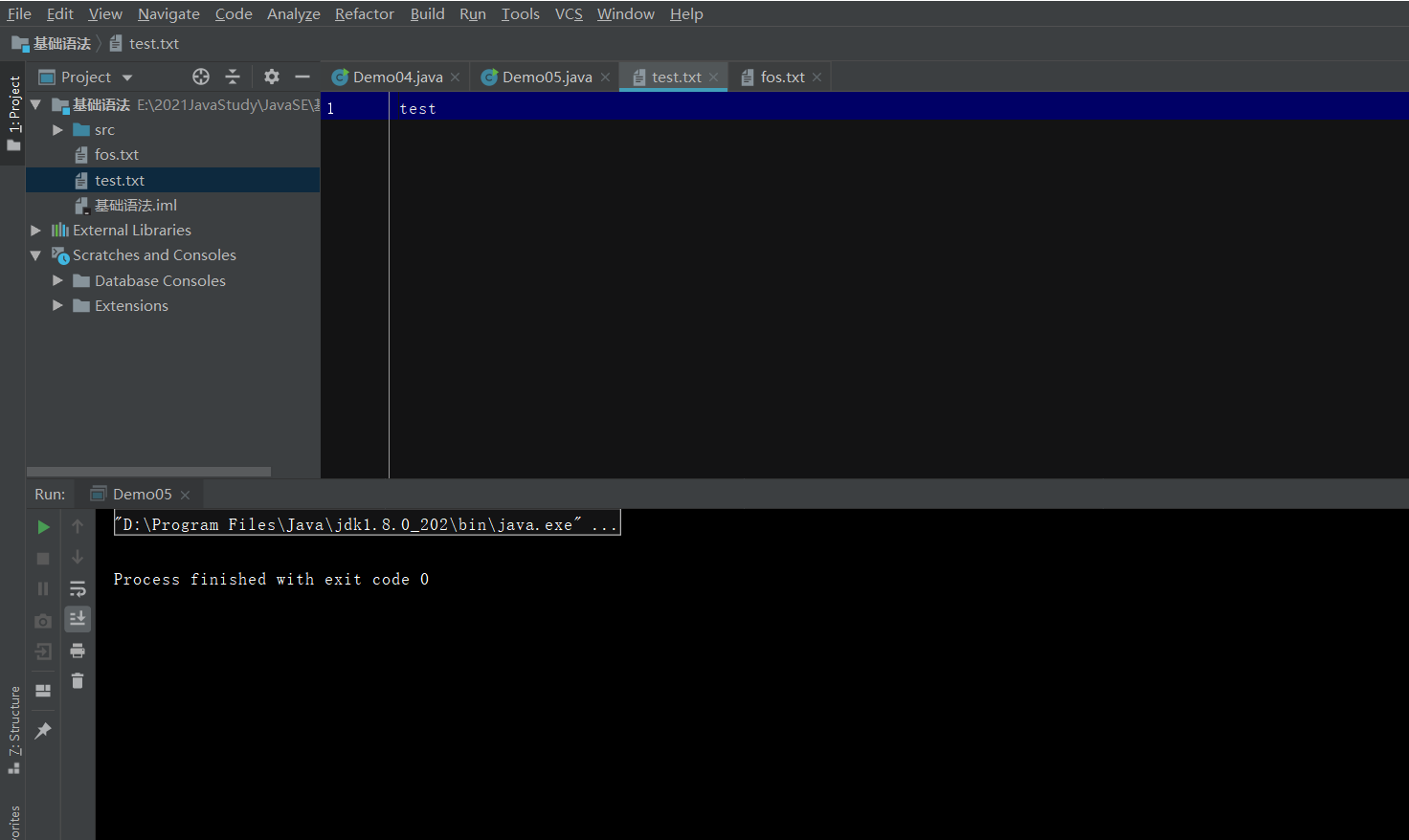字节流
字节流
字节流的概述和分类
IO流概述:
- IO:输入/输出(Input/Output)
- 流:
- 是一种抽象概念,是对象传输的总称。
- 也就是说数据在设备间的传输称为流。
- 本质是数据传输
- IO流就是用来设备间数据传输问题的
- 常见应用:文件复制、文件上传、文件下载
IO流分类:
- 按照数据流向:
- 输入流:读数据
- 输出流:写数据
- 按照数据类型来分
- 字节流
- 字节输入流;字节输出流
- 字符流
- 字符输入流;字符输出流
- 字节流
- 一般按照数据类型来分
- 使用场景:
- 能用记事本打开且能读懂,就使用字符流;
- 否则使用字节流(万能)。
字节流
1.字节流抽象基类
- InputStream:这个抽象类是表示字节输入流的所有类的超类
- OutputStream:这个抽象类是表示字节输出流的所有类的超类
- 子类名特点:以其父类名作为其子类名的后缀
FileOutputStream:文件输出流用于将数据写入File
- FileOutputStream(String name):
- 创建文件输出流以指定的名称写入文件
2.步骤:
IO流写入数据:
1.写对象
(1).调用系统功能创建了文件
(2).创建了字节输出流对象
(3).让字节输出流指向创建好的文件
2.调用字节输出流对象写数据
3.释放资源
3.字节流写数据的三种方式
(1)void write(int b)
将指定的字节写入此文件输出流,一次写一个字节数据
(2)void write(byte[] b)
将b.length字节从指定的字节数组写入此文件输出流
一次写一个字节数组数据
(3)void write(byte[] b,int off,int len)
将len字节从指定的字节数组开始,从偏移量off(开始索引位置)开始写入此文件输出流
一次写一个字节数组的部分数据
4.字节流写数据的两个小问题
-
字节流如何实现换行:
windows:\r\n Linux:\n Mac:\r -
字节流写数据如何实现追加写入呢?
public FileOutputStream(String name,boolean append)
创建文件输出流以指定的名称写入文件。
如果第二个指定的参数为true,则将写入文件的末尾而不是开头
5.字节流数据加异常处理
- try/catch处理

//catch块
} catch (IOException e) {
e.printStackTrace();
} finally {
if (fos != null){
try {
fos.close();//关闭资源
} catch (IOException e) {
e.printStackTrace();
}
}
}
6.字节流读数据(一次读一个字节数据)
-
需求:把文件中的fos.txt中的内容读取出来在控制台输出
FileInputStream:从文件系统中输入字节
-
FileInputStream(String name):通过打开与实际文件连接来创建一个FileInputStream,该文件由文件系统中的路径名name命名
-
使用步骤:
- 1.创建字节输入流对象
- 2.调用字节输入流对像的读数据方法
- 3.释放资源
//字节流读数据标准写法
int by;
while((by=fis.read()) != -1){
System.out.print((char)by);
}
案例:复制文本文件
分析:

- 思路:

练习:
public static void main(String[] args) throws IOException {
FileInputStream fis = new FileInputStream("E:\\2021Study\\test.txt");
FileOutputStream fos = new FileOutputStream("基础语法\\test.txt");
int by;
while ((by=fis.read())!= -1){
fos.write(by);
}
fos.close();
fis.close();
}
运行结果:

案例:字节流读数据
package com.guoba.day1222;
import java.io.FileInputStream;
import java.io.IOException;
/*
需求:
把文件fos.txt中的内容读取出来在控制台输出
使用字节流输入数据的步骤:
1.创建字节输入流对象
2.调用字节输入流对象的读数据方法
3.释放资源
*/
public class Demo01 {
public static void main(String[] args) throws IOException {
FileInputStream fis = new FileInputStream("基础语法\\fis.txt");
// byte[] bytes = new byte[5];
//
// int readlen = fis.read(bytes);
// System.out.println(readlen);
// System.out.println(new String(bytes));
//
// readlen = fis.read(bytes);
// System.out.println(readlen);
// System.out.println(new String(bytes));
//
// readlen = fis.read(bytes);
// System.out.println(readlen);
// System.out.println(new String(bytes));
//
// readlen = fis.read(bytes);
// System.out.println(readlen);
// System.out.println(new String(bytes));
byte[] bytes = new byte[1024];//数组长度为1024或其整数倍
int len;
//循环改进
while((len = fis.read(bytes))!=-1){
System.out.println(new String(bytes,0,len));
}
fis.close();
}
}
案例:复制图片
package com.guoba.day1222;
import java.io.FileInputStream;
import java.io.FileOutputStream;
import java.io.IOException;
/*
复制图片
需求:把 数据源图片 复制到 目标地址
思路:
1.根据数据源创建字节输入流对象
2.根据目的地创建字节输入流对象
3.读写数据,复制图片(一次读取一个字节数组,一次写入一个字节数组)
*/
public class Demo02 {
public static void main(String[] args) throws IOException {
FileInputStream fis = new FileInputStream("E:\\2021Study\\西施.jpg");
FileOutputStream fos = new FileOutputStream("基础语法\\西施.jpg");
byte[] bytes = new byte[2048];
int len;
while ((len=fis.read(bytes))!=-1){
fos.write(bytes);
}
}
}
7.字节缓冲流
字节缓冲流:
- BufferOutputStream:该类实现缓冲输出流。通过设置这样的输出流,应用程序可以向底层输出流写入字节,而不必为写入的每个字节导致底层系统的调用
- BufferedInputStream:创建BufferdedInputStream将创建一个内部缓冲区数组。当从流中读取或跳过字节时,内部缓冲区将根据需要从所包含的输入流中重新填充,一次很多字节
构造方法:
- 字节缓冲输出流:BufferedOutputStream(OutputStream out)
- 字节缓冲输入流:BufferedInputStream(InputStream in)
package com.guoba.day1222;
import java.io.*;
public class Demo03 {
public static void main(String[] args) throws IOException {
//创建字节缓冲输出流对象
BufferedOutputStream bos = new BufferedOutputStream(new FileOutputStream("基础语法\\bos.txt"));
//写数据
bos.write("hello\r\n".getBytes());
bos.write("world\r\n".getBytes());
//释放资源
bos.close();
BufferedInputStream bis = new BufferedInputStream(new FileInputStream("基础语法\\bos.txt"));
//一次读一个字节
int by;
while ((by=bis.read())!= -1){
System.out.print((char)by);
}
//一次读一个字节数组
byte[] bytes = new byte[1024];
int len;
while ((len = bis.read(bytes)) != -1) {
System.out.print(new String(bytes,0,len));
}
bis.close();
}
}
案例:复制视频
package com.guoba.day1222;
import java.io.*;
/*
需求:把 数据源视频 复制到 目标地址
思路:
1.根据数据源创建字节输入流对象
2.根据目的地创建字节输出流对象
3.对写数据,复制视频
4.释放资源
方式:
》基本字节流一次读取一个字节
》基本字节流一次读写一个字节数组
》字节缓冲流一次读写一个字节
》字节缓冲流一次读写一个字节数组
*/
public class Demo04_CopyVideo {
public static void main(String[] args) throws IOException{
long startTime = System.currentTimeMillis();//记录开始时间
//method1();
//method2();
//method3();
method4();
long endTime = System.currentTimeMillis();//记录结束时间
System.out.println("共耗时:"+(endTime-startTime)+"毫秒");
}
//字节流一次读取一个字节:共耗时:25807毫秒
public static void method1()throws IOException {
FileInputStream fis = new FileInputStream("E:\\2021Study\\test.mp4");
FileOutputStream fos = new FileOutputStream("基础语法\\test.mp4");
int by;
while ((by=fis.read())!= -1){
fos.write(by);
}
fis.close();
fos.close();
}
//字节流一次读写一个字节数组:共耗时:61毫秒
public static void method2()throws IOException {
FileInputStream fis = new FileInputStream("E:\\2021Study\\test.mp4");
FileOutputStream fos = new FileOutputStream("基础语法\\test.mp4");
byte[] bytes = new byte[1024];
int len;
while ((len=fis.read(bytes))!= -1){
fos.write(bytes,0,len);
}
fis.close();
fos.close();
}
//字节缓冲流一次一字节:共耗时:210毫秒
public static void method3()throws IOException {
BufferedInputStream bis = new BufferedInputStream(new FileInputStream("E:\\2021Study\\test.mp4"));
BufferedOutputStream bos = new BufferedOutputStream(new FileOutputStream("基础语法\\test.mp4"));
int by;
while ((by=bis.read())!=-1){
bos.write(by);
}
bos.close();
bis.close();
}
//字节缓冲流一次一字节数组:共耗时:714毫秒
public static void method4()throws IOException {
BufferedInputStream bis = new BufferedInputStream(new FileInputStream("E:\\2021Study\\test.mp4"));
BufferedOutputStream bos = new BufferedOutputStream(new FileOutputStream("基础语法\\test.mp4"));
byte[] bytes = new byte[1024];
int len;
while ((len=bis.read())!= -1){
bos.write(bytes,0,len);
}
bos.close();
bis.close();
}
}


 浙公网安备 33010602011771号
浙公网安备 33010602011771号